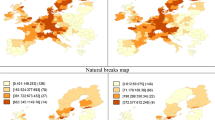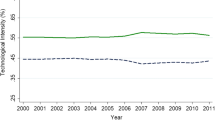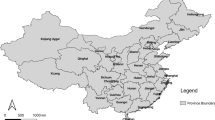Abstract
This paper studies the effects of spatial concentration of innovation activity on local production of patents in the US. In doing so, we augment the standard knowledge production function with a structure that allows for spatial effects, accounting along with bilateral also for multilateral influences across states. Our findings corroborate with past evidence on the important role of state’s own R&D stock and human capital in producing new inventions. In addition, external knowledge, via spatial interactions, is also a purveyor of local innovation production. The effect is stronger when we consider spatial influences from all states, in particular from the most innovative ones, and to a lesser extent from close neighboring states. Finally, spillovers are more likely to occur between states with similar technological specialization, which share common technological knowledge and pour similar technological effort.

Similar content being viewed by others
Notes
For more specifications of weight matrices, see Anselin et al. (1996).
The potential endogeneity bias arises because, while some states’ innovation performance has an impact on state’s i innovation activity, state i’s activity may also have reverse impact on other states’ innovation activity.
Alternative error term structures are the spatial error component model, e j = λΣ i≠j w ij ξ i +υ j , and the spatial moving average model, e j = λΣ i≠j w ij e i +υ j , as discussed in Deltas and Karkalakos (2003).
The level of technological capability of a region is often proxied in the literature (Peri 2005) by the level of R&D activity and human capital (number of researchers). According to innovation-driven models of growth (Grossman and Helpman 1991; Aghion and Howitt 1997), R&D stimulates innovation and facilitates the imitation of others’ discoveries. Apart from contributing directly to invention, human capital also accounts for aspects of innovation not captured by the R&D sector, including ‘learning-by-doing’ and ‘on-the-job-training’ (Romer 1989; Redding 1996).
Structural proximity between two states is measured as in Jaffe (1986). We first classify each patent, according to their primary US Classification, in one of the 37 technology fields, as defined in Hall and Ziedonis (2001). Then, for each state, we create a patent profile by taking the vector of shares of patents issued in technology field, Sh i = (sh i1,sh i2, ... , sh i37, for a given year.
The database is available at: http://sites.google.com/site/patentdataproject.
Data extracted from the National Science Foundation database is given biannually. We use STATA’s interpolation methods to fill in the gaps.
Following the literature, we have tried different depreciation percentages, e.g., 15 %, and 20 %. The resulted R&D stocks are highly correlated.
References
Aghion, P., & Howitt, P. (1997). Endogenous growth theory. Massachusetts: MIT Press.
Anselin, L. (1988). Spatial econometrics, methods and models. Boston: Kluwer Academic.
Anselin, L., Bera, A., Yoon, F.M. (1996). Simple diagnostic tests for spatial dependence. Regional Science and Urban Economics, 26(1), 77–104.
Arrow, K. (1962). The rate and direction of inventive activity: economic and social factors. In R. Nelson (Ed.), Economic welfare and the allocation of resources for invention (pp. 609–625). Princeton: Princeton University Press.
Baltagi, B., & Lui, L. (2011). Instrumental variable estimation of a spatial autoregressive panel model with random effects. Economics Letters, 111(2), 135–137.
Blomstrom, L., & Kokko, A. (1998). Multinational corporations and spillovers. Journal of Economic Surveys, 12(3), 247–277.
Bode, E. (2004). The spatial pattern of localized r&d spillovers: an empirical investigation for germany. Journal of Economic Geography, 4(1), 43–64.
Bottazzi, L., & Peri, G. (2007). The international dynamics of r&d and innovation in the long run and in the short run. Economic Journal, 117(518), 486–511.
Branstetter, L.G. (2001). Are knowledge spillovers international or intranational in scope?: Microeconometric evidence from the U.S. and Japan. Journal of International Economics, 53(1), 53–79.
Cameron, G., Proudman, J., Redding, S. (2005). Technological convergence, r&d, trade and productivity growth. European Economic Review, 49(3), 775–809.
Coe, D., & Helpman, E. (1995). International R&D spillovers. European Economic Review, 39(5), 859–887.
Deltas, G., & Karkalakos, S. (2013). Similarity of r&d activities, physical proximity, and r&d spillovers. Regional Science and Urban Economics, 43(1), 124–131.
Griffith, R., Redding, S., van Reenen, J. (2004). Mapping the two faces of r&d: productivity growth in a panel of oecd industries. Review of Economics and Statistics, 86(4), 883–895.
Griliches, Z. (1979). Issues in assesing the contribution of r&d to productivity growth. Bell Journal of Economics, 10(1), 92–116.
Grossman, G., & Helpman, E. (1991). Innovation and growth in the global economy. Massachusetts: MIT Press.
Guellec, D., & van Pottelsberghe de la Potterie, B. (2004). From r&d to productivity growth: do the institutional settings and the source of funds of r&d matter? Oxford Bulletin of Economics and Statistics, 66(3), 353–378.
Hall, B., & Ziedonis, R. (2001). The patent paradox revisited: an empirical study of patenting in the U.S. semiconductor industry, 1979–1995. RAND Journal of Economics, 32(1), 101–128.
Jacobs, J. (1969). The economy of cities. New York: Random House.
Jaffe, A.B. (1986). Technological opportunity and spillovers of r&d: evidence from firms’ patents, profits, and market value. American Economic Review, 76(5), 984–1001.
Kelejian, H., & Prucha, I. (1998). A generalized spatial two-stage least squares procedure for estimating a spatial autoregressive model with autoregressive disturbances. Journal of Real Estate Finance and Economics, 17(1), 99–121.
Keller,W. (2002). Trade and the transmission of technology. Journal of Economic Growth, 7(1), 5–24.
Lee, L. (2003). Best spatial two-stage least square estimators for a spatial autoregressive model with autoregressive disturbances. Econometric Reviews, 22(4), 307–335.
Marshall, A. (1890). Principles of economics. London: Macmillan.
Pace, R., & LeSage, J. (2007). Omitted variables biases of ols and spatial lag models. In A. Pez, J. Le Gallo, R. Buliung, S. Dallerba (Eds.), Progress in spatial analysis: theory and computation, and thematic applications. Berlin: Springer.
Pakes, A., & Griliches, Z. (1980). Patents and r&d at the firm level: a first report. Economics Letters, 5(4), 377–381.
Parent, O., & LeSage, J. (2008). Using the variance structure of the conditional autoregressive specification to model knowledge spillovers. Journal of Applied Econometrics, 23(2), 235–256.
Peri, G. (2005). Determinants of knowledge flows and their effect on innovation. Review of Economics and Statistics, 87(2), 308–322.
Redding, S. (1996). The low-skill, low-quality trap: strategic complementarities between human capital and r&d. The Economic Journal, 106(435), 458–470.
Romer, P. (1986). Increasing returns and long-run growth. Journal of Political Economy, 94(5), 1000–1037.
Romer, P.M. (1989). Human capital and growth: theory and evidence. National Bureau of Economic Research Working Paper Series No. 3173.
Acknowledgments
We are grateful to George Dellas and to an anonymous referee for useful comments. Kyriakos Drivas gratefully acknowledges financial support from the National Strategic Reference Framework No: SH1_4083. The usual disclaimer applies.
Author information
Authors and Affiliations
Corresponding author
Appendix
Appendix
Rights and permissions
About this article
Cite this article
Drivas, K., Economidou, C. & Karkalakos, S. Spatial Aspects of Innovation Activity in the US. J Knowl Econ 5, 464–480 (2014). https://doi.org/10.1007/s13132-014-0198-3
Received:
Accepted:
Published:
Issue Date:
DOI: https://doi.org/10.1007/s13132-014-0198-3




